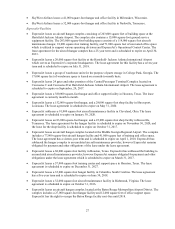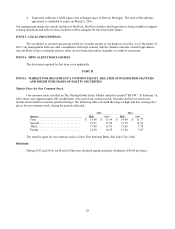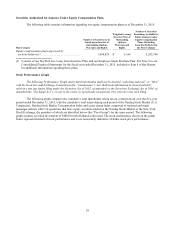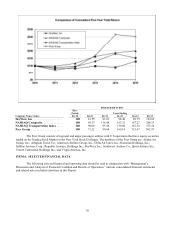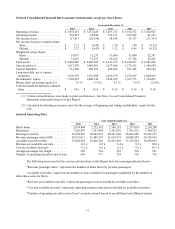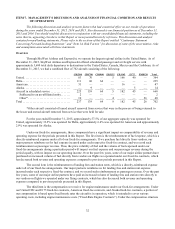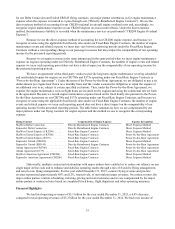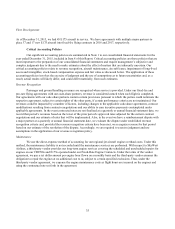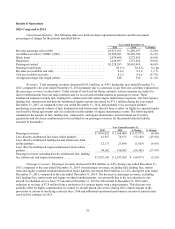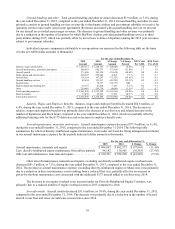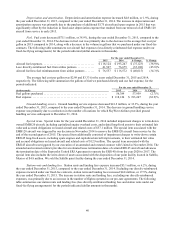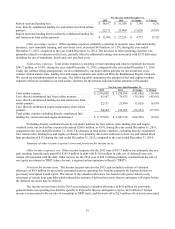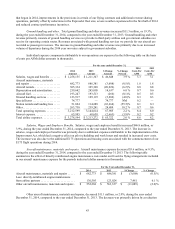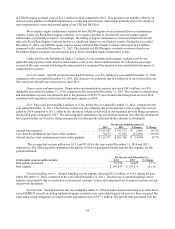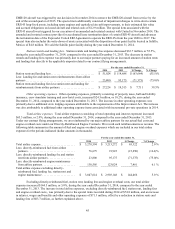SkyWest Airlines 2015 Annual Report Download - page 40
Download and view the complete annual report
Please find page 40 of the 2015 SkyWest Airlines annual report below. You can navigate through the pages in the report by either clicking on the pages listed below, or by using the keyword search tool below to find specific information within the annual report.36
Aircraft Leases
The majority of SkyWest Airlines’ aircraft are leased from third parties, while the majority of ExpressJet’s
aircraft flying for Delta and American are debt-financed. All of ExpressJet’s ERJ145 aircraft flying for United are leased
from United for nominal amounts and all of ExpressJet’s ERJ145 aircraft flying for American are leased from American
for nominal amounts. In order to determine the proper classification of our leased aircraft as either operating leases or
capital leases, we must make certain estimates at the inception of the lease relating to the economic useful life and the
fair value of an asset as well as select an appropriate discount rate to be used in discounting future lease payments. These
estimates are utilized by management in making computations as required by existing accounting standards that
determine whether the lease is classified as an operating lease or a capital lease. All of our aircraft leases have been
classified as operating leases, which results in rental payments being charged to expense over the terms of the related
leases. Additionally, operating leases are not reflected in our consolidated balance sheet and accordingly, neither a lease
asset nor an obligation for future lease payments is reflected in our consolidated balance sheets. See “Recent Accounting
Pronouncements” set forth below for a discussion of a recently-adopted new accounting standard that is likely to have an
impact on our aircraft lease accounting beginning in 2019.
Impairment of Long-Lived Assets
As of December 31, 2015, we had approximately $3.5 billion of property and equipment and related assets net
of accumulated depreciation. Additionally, as of December 31, 2015, we had approximately $10.5 million in intangible
assets. In accounting for these long-lived and intangible assets, we make estimates about the expected useful lives of the
assets, the expected residual values of certain of these assets, and the potential for impairment based on the fair value of
the assets and the cash flows they generate. We recorded an intangible of approximately $33.7 million relating to the
acquisition of Atlantic Southeast in September 2005. That intangible is being amortized over fifteen years under the
straight-line method. As of December 31, 2015, we had recorded $23.3 million in accumulated amortization expense.
Factors indicating potential impairment include, but are not limited to, significant decreases in the market value of the
long-lived assets, a significant change in the condition of the long-lived assets and operating cash flow losses associated
with the use of the long-lived assets.
When considering whether or not impairment of long-lived assets exists, we group similar assets together at the
lowest level for which identifiable cash flows are largely independent of the cash flows of other assets and liabilities and
compare the undiscounted cash flows for each asset group to the net carrying amount of the assets supporting the asset
group. Asset groupings are done at the fleet type or contract level.
Stock-Based Compensation Expense
We estimate the fair value of stock options as of the grant date using the Black-Scholes option pricing model.
We use historical data to estimate option exercises and employee termination in the option pricing model. The expected
term of options granted is derived from the output of the option pricing model and represents the period of time that
options granted are expected to be outstanding. The expected volatilities are based on the historical volatility of our
common stock and other factors.
Fair value
We hold certain assets that are required to be measured at fair value in accordance with United States GAAP.
We determined fair value of these assets based on the following three levels of inputs:
Level 1—Quoted prices in active markets for identical assets or liabilities.
Level 2—Observable inputs other than Level 1 prices such as quoted prices for similar assets
or liabilities; quoted prices in markets that are not active; or other inputs that are
observable or can be corroborated by observable market data for substantially the
full term of the assets or liabilities. Some of our marketable securities primarily
utilize broker quotes in a non-active market for valuation of these securities.
Level 3—Unobservable inputs that are supported by little or no market activity and that are
significant to the fair value of the assets or liabilities, therefore requiring an entity
to develop its own assumptions.



